Field management
Weed management
Groundnut cannot compete effectively with weeds, particularly at the early stages of growth, from 3 to 6 weeks after sowing. Therefore, noxious weeds like couch grass or spear grass should be hand-sorted during land preparation to reduce competition with growing groundnut plants.
The use of herbicides is not allowed in organic production. Therefore, after groundnut establishment, organic farmers must weed at least twice during the growing season. The first weeding can be done mechanically, for example with a hoe. Once pegging begins, hand-weeding or light use of the hoe is recommended, so as not to interfere with the developing pods.
Soil fertility management
Groundnut is a legume and therefore has the natural ability to fix nitrogen from the air and soil with the help of bacteria, called Bradyrhizobium, in root nodules. This reduces its need for fertiliser. The amount of nitrogen that groundnut plants can accumulate in root nodules is higher than most other tropical legumes. Thanks to the nitrogen fixing bacteria, groundnut can cover about 3/4 of its nitrogen needs itself, if the bacteria is present in the soil.
The nitrogen does not only serve the groundnut, but also improves the yield of the crop grown after groundnut, e. g. maize. Groundnut hay or stover that remain on the field after harvest or are returned to the field after the peanut pods are harvested contains residual nitrogen in the vines, leaves and roots. These can be tilled back into the soil to decompose and naturally fertilise the field for the next crop.
The groundnut extensive root system allows the crop to effectively use fertiliser or manure applied to previous crops in the rotation. In organic production, the application of organic fertilisers is recommended not only to supply nutrients, but also to balance soil acidity, thus increasing groundnut yields, especially on infertile soils. However, it is not recommended to apply too much manure, because it promotes excessive vegetative growth of the groundnut due to the excessive N supply. It is recommended to apply between 5 to 10 t/ha of manure depending on the type and characteristics of the manure, the fertility of the soil. Additional plant needs for phosphorus can be met through use of rock phosphate products such as Minjingu phosphate rock (MPR) from northern Tanzania. To find out about possible sources of phosphate rock, farmers should contact their organic experts.
Addition of organic materials, such as compost – and to some extent also farmyard manure and crop residues – improves the water-holding capacity of the soil, thereby reducing the fungal colonisation and the accumulation of aflatoxin in the groundnut seeds. The common practice among Malawi farmers of burning crop residues exposes the soil to erosion and loss of organic matter. This practice is thus not allowed in organic production.
For further details on compost production, please see the poster and the guidance note on ' How to Make Good Quality Compost', and the Soil Fertility Module of the African Organic Agriculture Training Manual at www.organic-africa.net.
Discussion on soil fertility management in groundnut
Inquire about the participants’ knowledge on soil fertility management, asking whether they have experienced or observed any decline in the fertility of their soils, and what they think are the main causes of this decline. Split the participants into small groups and invite them to discuss the availability of organic fertilisers for groundnut production. Ask the sub-groups to present their propositions, how soil fertility and nutrient supply to groundnut fields can be improved according to local conditions.
Pest and disease management during production
Several pests and diseases can cause major yield losses. Groundnut rosette and early and late leaf spot (diseases), and aphids and termites (pests) are of economic importance for groundnut production in Malawi.
Inquiry about common pests and diseases in groundnut production
Ask the farmers the following questions to inquire about their challenges and approaches in pest and disease management:
- Which are the most important pests and diseases in your area?
- Which techniques do you use to manage these pests and diseases? Evaluate the advantages and disadvantages of different approaches.
Key groundnut diseases
Groundnut Rosette
Groundnut Rosette, also known as Kadukutu, Khate, in Chichewa and Kaligwiti, Khate in Tumbuka, is the most destructive disease of groundnut. It can cause 100 % loss of yield in severe cases, as plants affected when young may produce no nuts. If the disease occurs at flowering, yield losses are also very large.
Affected groundnut plants take on a bushy appearance due to stunting and distortion of the growing shoots. The leaves appear both as ‘chlorotic’ (yellow and stunted) and ‘green’ (green and stunted). Younger leaves may show mottling and flecking while older leaves may be small and very deep green and have inrolled margins.
The groundnut Rosette disease is common in Malawi. It is more serious during years with serious drought. The disease can spread rapidly through a crop.
Groundnut Rosette is a viral disease transmitted by aphids such as the groundnut aphid (Aphis craccivora). The only way to control the virus once a plant is infected is to destroy the plant.
Preventive measures:
- Cultivating varieties that are resistant to the rosette disease such as Baka, Chitala and Nsinjiro is very effective. The Chalimbana 2005 variety has moderate resistance.
- Early, dense planting with the first good rains helps to reduce infestations by aphids by covering the soil as quickly as possible and restricting the movement of the aphids. Late planted crops suffer heavy attacks by aphids that transmit the viral particle.
- Interplanting groundnut with other crops such as maize, beans or sorghum is effective in reducing the disease incidence as this confuses the aphids’ movement.
- Rogueing and destroying infected plants by either burning or deep burying reduces further spreading of the disease.
- Volunteer groundnut plants should be removed and burned, as they may contribute to the development of the disease in the next season.
- Neem seed or leaf extracts can be applied against aphids to limit the further spreading of the disease.
Early and late leaf spot
Late and early leaf spots are considered to be the most serious and widespread diseases of groundnut globally. In areas or situations where fungicides are not used, pod yield losses can be as high as 50 %. At about one month after planting, small spots with yellow halos can appear on the upper side of older leaves. These are signs of early leaf spot. The spots are brown on the lower leaf surface. Between 6 to 8 weeks after sowing, larger, circular black spots appear, which are signs of late leaf spot. The spots also appear on the stems and petioles. Temperatures of 25 to 30 °C and 6 to 8 hours of high humidity are needed for infection and disease development. The diseases are due to largely soilborne fungi that survive mainly on crop residues in the soil and on volunteer crops that grow from the previous season.
There are a number of measures that can help prevent the disease:
- Rotation of groundnut with other crops is very important to create a distinct break in time between successive groundnut crops in a field. It reduces survival of the spores of the fungus in the soil.
- Deeply burying, burning or feeding of the residues of groundnut crops to animals after harvest reduces inoculum that may infect the new crop. Burning of crop residues in the field is though not allowed in organic farming unless necessitated by the control of serious pests or diseases.
- Volunteer groundnut plants and other host plants of the fungus should be eradicated between groundnut crops.
- Upwind planting of new groundnut crops as far away as possible from previous infected groundnut crops reduces infection of the new crop.
- Resistant or tolerant, early yielding varieties limit the negative impact of early leaf spot. Chalimbana 2005 variety has moderate resistance to the disease.
- Removing volunteer plants and weeds reduces humidity in the crop stand and thus limits risks of infection.
Infected plants must be removed and buried deep in the soil or burned. They must not be composted, as the spores may survive in the compost and infect new crops.
Leaf rust
Leaf rust can easily be confused for leaf spot. The disease shows as orange-red pustules on the leaves, which later turn dark brown, and causes curling of leaves and defoliation. The disease is of little consequence, if it appears after the pegging and podding stage. Like leaf spot, the fungus survives on crop residues, volunteer plants and host weeds. A proper crop rotation, removal of volunteer plants and weeds, and burying crop residues during early land preparation can significantly reduce leaf rust.
Key groundnut pests
Aphids
The groundnut aphid (Aphis craccivora) attacks and sucks sap from the tender parts of the growing groundnut plant, like leaf and flower shoots. The removal of sap by the aphids weakens the plants. This causes poor and stunted growth, leaf curling and distorted leaf growth, wilting and reduces resistance to drought conditions, all resulting in yield losses. In addition, the aphids are important vectors in the transmission of the Rosette disease virus.
A proper crop rotation, removal of volunteer plants and weeds, intercropping, and burying crop residues during early land preparation can significantly reduce aphid infestations. Tolerant or resistent varieties can be used, if available. The promotion of natural enemies such as Ladybird beetles (Coccinellidae) and hoverflies (Syrphidae), and parasitic wasps and flies can (among others) contribute significantly to the control of aphids in groundnuts. Ladybird beetles, hoverflies, and parasitic wasps and flies can be promoted with selected flowering plants that provide pollen and nectar for the development of large populations of these natural enemies.
To limit damages on the crop by the aphids and infections with the Rosette disease in case of a heavy infestation by aphids, potassium soap, quassia extract or neem seed or leaf extracts can be sprayed. These natural pesticides have a limited negative impact on beneficial insects.
Termites
Termites can damage groundnut roots and stems, and bore holes in the pods, thereby damaging nuts. When termites damage pods, they also provide an entry point for the Aspergillus fungi that produce aflatoxin.
To control termites, it is recommended to incorporate crop residues into the soil early enough. As they decompose, the residues produce a heat, which repels termites. Planting early can result in healthier and more vigorous plants, which can better tolerate termite attack. Harvesting promptly to ‘escape’ termite damage is another useful measure.
The use of synthetic termiticides is not allowed in organic production. In severe cases, destroying the termite mounds and removing the queen termites may be necessary. To remove the queen, it is important to seek for expert information from the local extension staff.
Groundnut leafminer
The groundnut leafminer moth (Aproaerema modicella) can reach epidemic densities and create severe yield losses in Malawi. The mottled moth lays eggs on the underside of the groundnut leaf and petioles. Yellowish green caterpillars hatch, tunnel into the leaves and feed between the upper and lower epidermis of the leaf. Mined leaves become distorted within a few days. When the grey-green caterpillars with a shiny black head emerge from their mines, they make a web around the leaves. Pupation takes place inside the webbed leaflets. Damaged leaves become brownish, rolled and dry. Severe cases of leafminer damage look like the crop has been burnt.
The pest can be managed using resistant varieties. However, practicing crop rotation with non-leguminous crops such as maize and sorghum reduces the leaf miner population. Further preventive measures are planting early at the start of the rains to avoid the pest build-up, intercropping groundnut with trap crops such as pearl millet and cowpea, and practicing a proper crop rotation. Removal of the alternative hosts and weeds (i.e. amaranthus, hyacinth bean (lablab), mung beans, and Indigofera hirsuta) four weeks after planting and at least two times later when weeds are seen, reduces the leafminer population.
Drought stressed plants are much more susceptible to leafminer attack than plants that have adequate moisture. Therefore, avoiding drought stress by irrigating or early sowing the crop to take advantage of the full season rains reduces damages by the groundnut leafminer.
Removing and crushing webbed leaves, in which the green larvae hide, reduces damages on the crop and limits further multiplication of the pest. Light, sticky or pheromone traps can be used to attract and catch the adult moths and to monitor the pest populations.
The moth can be controlled biologically by promoting natural enemies like Ladybird beetles, releasing Trichogramma chilonis at 50’000 per ha twice in a 7 to 10 day interval, and spraying neem or Bacillus thuringiensis (Bt) to control the larvae.
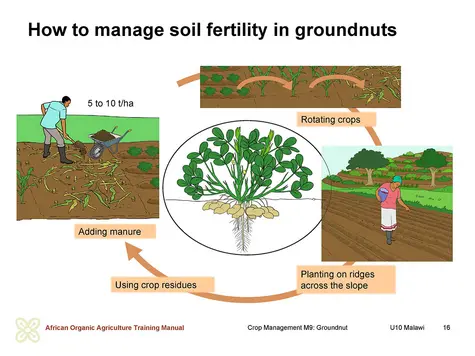
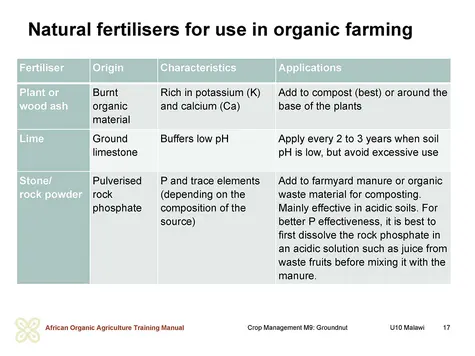
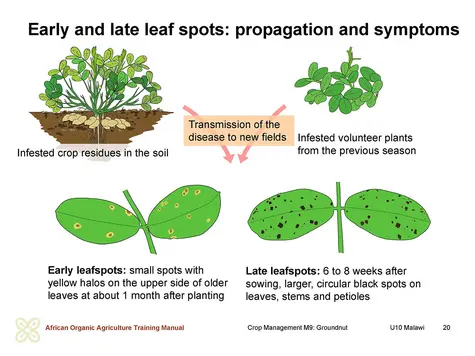
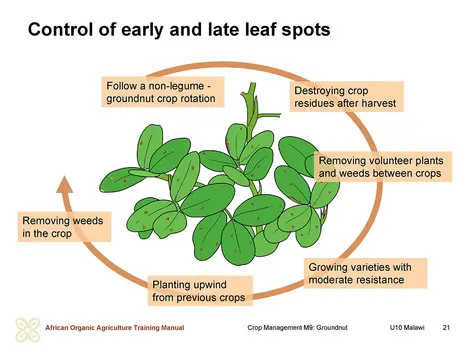
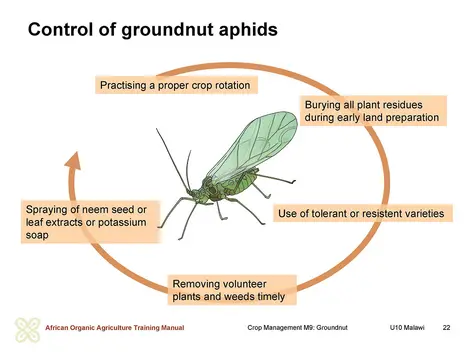
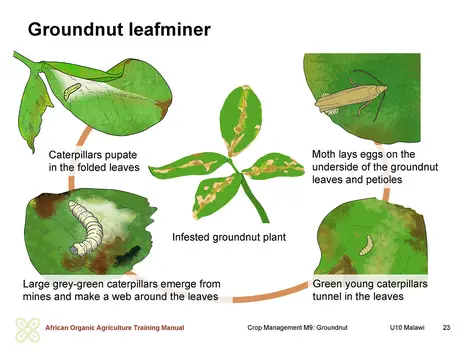
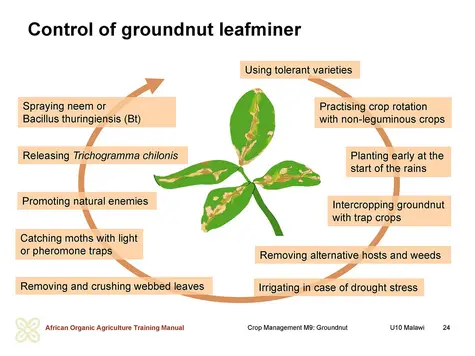
 tap and then scroll down to the Add to Home Screen command.
tap and then scroll down to the Add to Home Screen command.